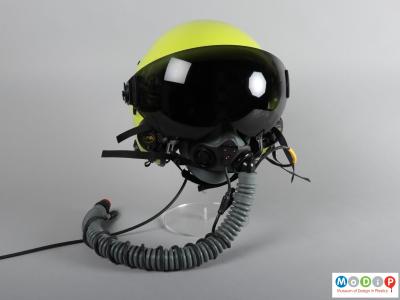In the early days of aviation, pilots adapted leather motor racing helmets as protection for their heads. Over time, military pilots and engineers added headphones, and throat microphones. In the 1930s, radio earphones, oxygen masks, and removable goggles where added. By the 1950s, the leather helmet and goggles were replaced by a hard helmet, made from a variety of materials including glass-reinforced plastic, and a built-in visor. Helmets are an essential piece of equipment for fighter jet pilots who are confined in a small space and likely to hit their head as they travel at speeds of an average of 1,600 mph, and in forces of up to 9 times that of gravity.
The Gentex Alpha 900 flying helmet (1) is a 2021 model and has been designed for both fixed and rotary wing aircraft (fixed-wing aircraft include those that are propeller driven or jet engine powered and have wings that do not move; rotary-wing aircraft are those that are powered by rotating blades, such as helicopters) and is intended for both civilian and military use. The helmet system which is based on an epoxy resin aramid and a carbon fibre one piece shell, is modular so that it can be built or adapted to include the user’s specific requirements. It covers the full head; top, sides from the temple area down to below the ears, and the back, for comprehensive protection, and has specified communications, respiratory, hearing, eye and face protection with replaceable and serviceable parts that contribute to reduced costs and improved deployment time.
This example has a quick-fit system, incorporating a ratchet nape adjustment to ensure helmet stability is maintained throughout the flight. It includes a dual visor, one being clear and one tinted, a MBU20 oxygen mask for high altitude flying, and Communication Ear Piece (CEP).

